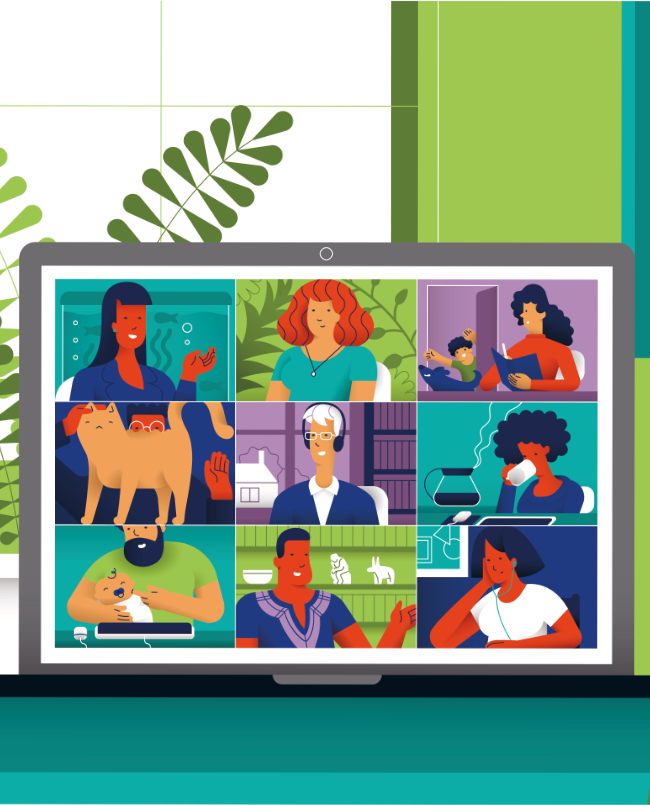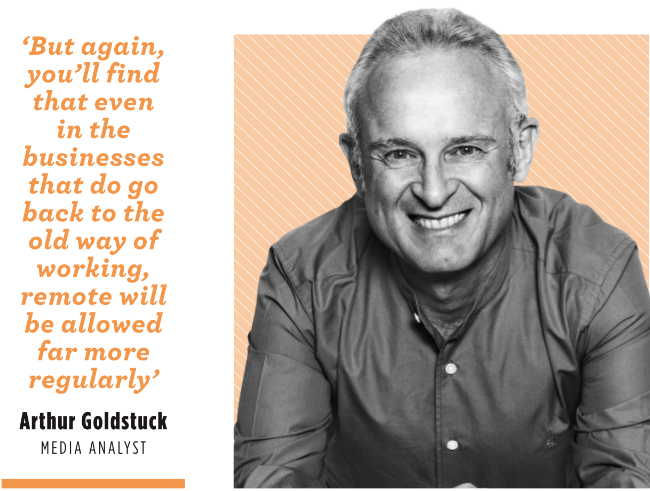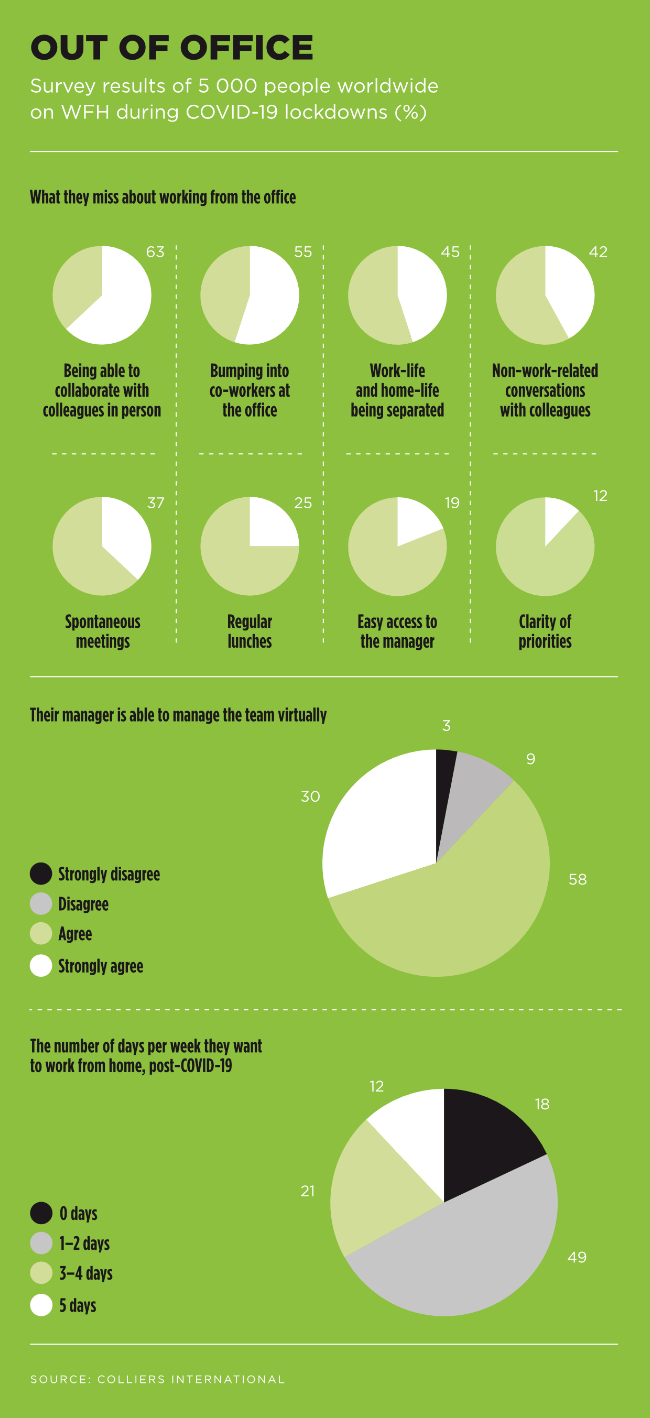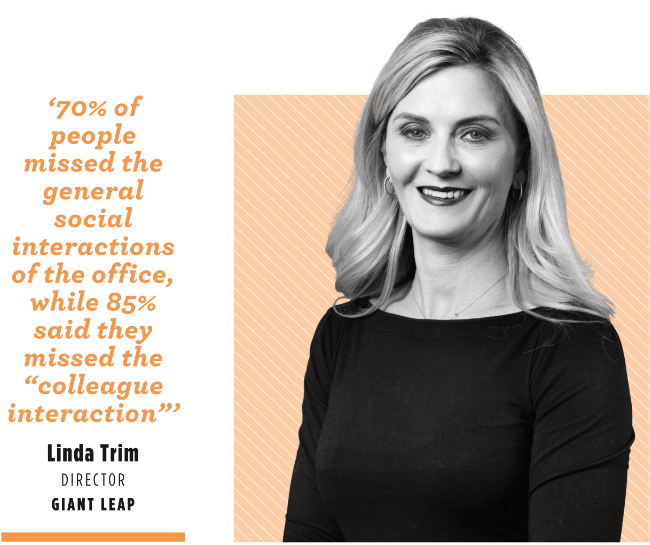Unless you’re a front-line health worker or provided an essential service, you will have joined millions of employees around the world in working from home during the COVID-19 lockdown. You’ll know the feeling of ‘Zoom fatigue’. You may have met up with friends or colleagues (virtually, of course) for ‘locktails’ and ‘quarantinis’. And you’ll certainly have enjoyed the short ‘commute’ from your bed to your desk. Chances are, despite the disruptions of the working from home – WFH – revolution, you’re as productive as you’ve ever been, even though you’re not in the office.
Apart from a handful of people who continued to go into the building as an essential service, the vast majority of the JSE’s staff worked from home through the lockdown, as JSE Group CEO Leila Fourie told the Daily Maverick. ‘I find people are working much harder,’ she said. ‘[Physical workplace] presence does not translate into productivity. Leaders [used to] have a false sense of security in employees showing up at the office.’
Fourie adds that the crisis (and, make no mistake, this was an unprecedented crisis) has unlocked a level of solidarity and unity in the team. ‘We’ve built a new level of trust.’
File-transfer service WeTransfer created a virtual-reality office space in which employees could interact via avatars, in a strange blend of the Sims computer game and TV sitcom the Office. ‘Those of us who have been working at WeTransfer for a while are able to live off the social capital we built up from all those serendipitous meetings and chats before,’ Gordon Willoughby, CEO of WeTransfer, told the Wall Street Journal. ‘For new people, that’s much harder. The 3D office is a really good way of maintaining that unplanned connectivity.’
Some companies, meanwhile, turned to monitoring tools such as Sneek, which watches workers through their laptop cameras, taking photographs every few minutes. Others logged their employees’ keystrokes in a bid to ensure their remote workers were actually working.
If that sounds creepy and invasive, that’s because it is. ‘We know lots of people will find it an invasion of privacy,’ Sneek co-founder Del Currie told Business Insider. ‘We 100% get that, and it’s not the solution for those folks, but there’s also lots of teams out there who are good friends and want to stay connected when they’re working together.’
Currie adds that ‘Sneek was never designed to spy on anyone. We’d be the worst spy company ever, considering we named our app Sneek’. But the line between promoting office culture – as these surveillance apps claim to do – and spying on employees in their homes has never been blurrier.
Trust is one of the biggest holdbacks of remote work, according to Kate Lister, president of research and consultancy firm Global Workplace Analytics. ‘Managers simply don’t trust their people to work untethered. They’re used to managing by counting butts-in-seats, rather than by results. That’s not managing; that’s babysitting.
‘What’s more, seeing the back of someone’s head tells a manager nothing about whether that person is actually working. When clients ask: “How will I know if they’re working?”, I ask: “How do you know they are working now?”.’
Global Workplace Analytics recently announced the findings of a new study, which estimates that between 25% and 30% of the US workforce will be working from home multiple days a week by the end of 2021.
As much as the COVID-19 lockdown was intended to be a temporary measure at a time of crisis, there’s a growing sense that the normal 9-to-5, in-the-office, at-your-desk working arrangement may be a thing of the past. Or is it?
‘I think our definition of “normal” has changed,’ says JP van Zittert, industrial psychologist. ‘We’ve passed the shock phase of the adjustment, so the big focus for business now is on creating stability for their employees. Some companies will go to the extreme. Some, given the current situation, are completely getting rid of their physical workplaces.’
Computer giant Dell has already confirmed that it expects more than half of its employees to work from home permanently, while social media giant Twitter made headlines after telling its 4 900 employees that many of them would be allowed to continue working from home – permanently – after the lockdown ends.
‘Tech companies could potentially go that route, but there are also companies that can’t because of the nature of their business,’ says Van Zittert. ‘I see us heading towards more of a middle ground: a hybrid model where staff come into the office on certain days of the week for meetings, client engagements or a specific outcome that can’t be achieved virtually.’
Media analyst Arthur Goldstuck agrees. When asked if he thinks SA businesses will go back to ‘normal’ after the lockdown, he says yes, and no. ‘One of the things that we’ll find across the different aspects of the way we live our lives – working, shopping and so on – is that part of the shift that we’ve all experienced will become permanent. But that doesn’t mean that we’re going to transition into this new way in totality.’
For Goldstuck, it’s a question of digital transformation – and here he draws parallels with the move towards e-commerce. ‘A large proportion of South Africans discovered online shopping during the lockdown, and many will continue shopping online, while many will go back to traditional shopping,’ he says. ‘Those who find online shopping comfortable, convenient and quick will carry on doing it; those who found it didn’t quite work for them will go back to the old way.
‘And even within that there are nuances. Some will become regular online shoppers, while some will now be willing to shop online on occasion. It’s going to be a varied approach, depending on the person’s experience and on their openness to the technology.’
This, he explains, can be extrapolated into the working environment as well. ‘Businesses that have found it difficult to have staff working remotely will go back to the old way,’ he says. ‘But again, you’ll find that even in the businesses that do go back to the old way of working, remote will be allowed far more regularly.’
Yet many employees don’t want to make a permanent move to WFH. A nationwide survey by workplace consultancy Giant Leap found that 86% of South Africans want to go back to working in an office. Giant Leap director Linda Trim says that while remote work was very popular at first, as time wore on people realised that it came with loneliness and a lack of work-life balance.
‘The survey showed 70% of people missed the general social interactions of the office, while 85% said they missed the “colleague interaction” while working at home,’ she says. To that point, about 81% of survey respondents said that working remotely made work communication harder, while more than half said they missed meeting, socialising and having ‘impromptu face time’ with their colleagues.
The erosion of company culture, then, is the biggest concern about – and the last great hurdle before – a complete move to remote working. Virtually every team that gathered together on Zoom meetings during the lockdown already knew each other and already had established relationships. Those bonds can erode over time and can be hugely difficult for new hires to build.
Difficult, but not impossible. ‘Culture is an expression of behaviour,’ says Van Zittert. ‘When you work remotely you can still have the same behaviours, but how you express them changes. If your group culture is based on empathy, caring, teamwork, agility, those won’t change. The channel for expressing them changes. In the past it would be person-to-person; now it’s digital.’
But for how long, and to what extent? In a new report on the post-COVID-19 workplace, global property company Colliers International predicts far-reaching changes to office occupancy, as businesses balance in-person collaboration with remote-working opportunities.
‘Attitudes towards remote working have been completely challenged by this global pandemic,’ says JanJaap Boogaard, head of Colliers International’s EMEA workplace advisory team. ‘The greatest surprise for many companies has been the realisation that their organisation can work remotely, be productive and stay connected. This awakening has started a new conversation for many businesses as they explore their work processes, business culture and question what the future is for their workplace.’
But, adds Boogaard, ‘the office is very much alive and kicking, because it is hard to create a compelling team culture when working remotely. We need face-to-face interaction in order to build true, meaningful connections’. He expects COVID-19 to be the catalyst for an evolution in office design as more businesses look at how to capitalise on remote working.
‘There are great examples of companies that have transformed their workplaces to supercharge teamwork, collaboration and creativity,’ says Boogaard. ‘However, many more need to follow suit. We predict this will become increasingly popular post-COVID-19, alongside increased remote working for those needing time to focus on specific tasks. It means that the way that space is designed and utilised will change, to further represent a business’ brand, culture and values.’
If – as many are predicting – the old model of Monday-to-Friday, 9-to-5 does indeed change to something more fluid and flexible, offices will have to change to meet those new requirements. Looking ahead, there’s the realisation that while the work may stay the same, and the workforce may adapt, some of the most interesting changes will happen in and to the workplace. Wherever that happens to be.











